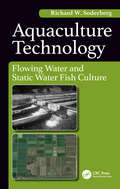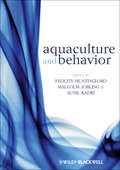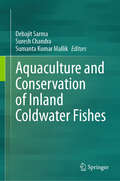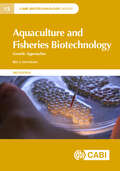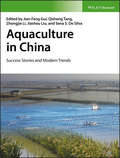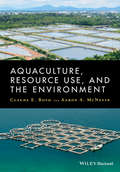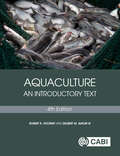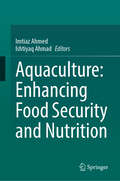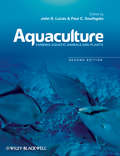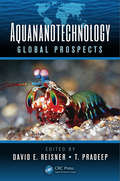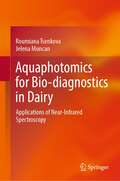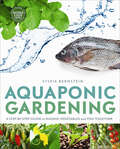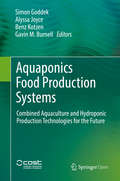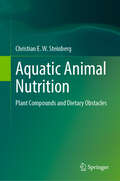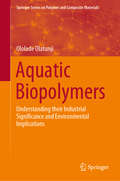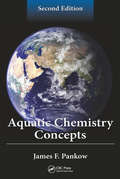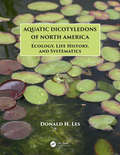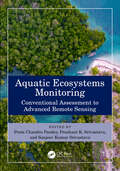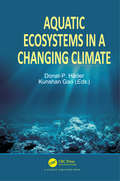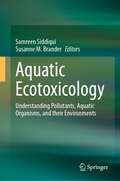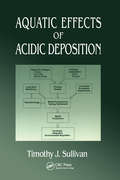- Table View
- List View
Aquaculture Science
by Rick ParkerThis comprehensive text introduces students to the aquaculture industry. It covers every aspect of aquaculture, including history, potential, descriptions, management, feeding, marketing, and diseases of aquatic animals and plants. Also addressed are the water requirements and chemistry necessary for successful aquaculture. The book offers detailed information on employment opportunities in the aquaculture industry. The science of aquaculture is stressed throughout to ensure that students understand the fundamental principles. The text includes numerous pedagogical features to ensure students' success.
Aquaculture Technology: Flowing Water and Static Water Fish Culture
by Richard Soderberg W.Key features: Takes a quantitative approach to the science of aquaculture Covers the complete landscape of the scientific basis of fish culture Promotes problem solving and critical thinking Includes sample problems at the end of most chapters Guides the reader through the technical considerations of intensive aquaculture, including fish growth rates, hydraulic characteristics of fish rearing units, oxygen consumption rates in relation to oxygen solubility and fish tolerance of hypoxia, and water reconditioning by reaeration and ammonia filtration. Discusses the environmental effects of aquaculture Includes a chapter on hatchery effluent control to meet receiving water discharge criteria Aquaculture Technology: Flowing Water and Static Water Fish Culture is the first book to provide the skills to raise fish in both a flowing water and a static water aquaculture system with a pragmatic and quantitative approach. Following in the tradition of the author’s highly praised book, Flowing Water Fish Culture, this work will stand out as one that makes the reader understand the theory of each type of aquaculture system; it will teach the user "how to think" rather than "what to think" about these systems. The book presents the scientific basis for the controlled husbandry of fish, whether it be in a stream of water or a standing water pool. Part 1, Flowing Water Fish Culture, is a major revision of the author’s initial book and includes greatly expanded coverage of rearing unit design criteria, fish growth and the use of liquid oxygen, hatchery effluent control, and recirculating systems. Part 2, Static Water Fish Culture, presents the scientific basis of fish culture in standing water systems including nutrient and dissolved gas dynamics, pond ecology, effects of fertilization and supplemental feeding, water quality management and representative static water aquacultures. Aquaculture Technology conveys the science in a manner appropriate for use by university students and teachers and others involved in fish production and aquaculture research and development worldwide. It will enable the reader to adapt to changing technologies, markets, and environmental regulations as they occur.
Aquaculture and Behavior
by Felicity HuntingfordModern aquaculture is faced with a number of challenges, including public concern about environmental impacts and the welfare of farmed fish. A fundamental understanding of fish biology is central to finding ways to meet these challenges and is also essential for maintaining the industry's sustainability. Furthermore, the behaviour of fish under culture situations has long been ignored despite heavy commercial losses that can result from fish stressed and hence disease-prone, due to bad husbandry techniques. This important book summarises the current understanding of the behavioural biology of farmed species and illustrates how this can be applied to improve aquaculture practice. Informative and engaging, Aquaculture & Behavior brings the reader up-to-date with major issues pertaining to aquaculture. Everyone from fish farmers to upper level students will find this book a valuable and practical resource. Libraries in universities and research establishments where animal behavior, aquaculture, veterinary and biological sciences are studied and taught should have copies of this work on their shelves.
Aquaculture and Conservation of Inland Coldwater Fishes
by Suresh Chandra Debajit Sarma Sumanta Kumar MallikThis book provides the latest information on trans-Himalayan Hindu Kush Region (HKR) fisheries including the Indian Himalayan Region (IHR) as well as the historical context of its sustainable development for improving livelihood and nutritional security. The book serves as an important document to provide knowledge and information about the major concerns of environmental and anthropogenic factors that have impacted the population of certain important fishes in the ecosystem and the strategies and policies required for the conservation of these important groups of fishes, viz., Mahseer, snow trout, minor carp, catfishes, etc. The chapters describe the information to the readers on potential cold water and cool water fish species suitable for large-scale farming and propagation addressing the issues of diseases, nutrigenomics, and nanobiotechnology. This book also addresses the prospects and potential of recreational fishing in India and the scope for its improvement to generate more employment and income citing the success stories and primary information from reputed anglers. Finally, the book also elucidates a comprehensive yet representative description of many challenges associated with inland coldwater- cool water fisheries and aquaculture in HKR, IHR, and its way forward.
Aquaculture and Fisheries Biotechnology: Genetic Approaches (CABI Biotechnology Series)
by Rex DunhamThe genetic improvement of fish for aquaculture and related fisheries has seen huge advances over recent years. Building upon the previous two editions of Aquaculture and Fisheries Biotechnology: Genetic Approaches, this 3rd edition offers a presentation of traditional selective breeding, modern genetic biotechnology, genomics, gene transfer and gene editing, and the latest developments in genetic biotechnology such as epigenetics, xenogenesis and genome-wide association study coupled with commercial application, the impact of government regulation and expectations for the future. It provides a firm grounding in relevant aspects of classical genetics, before focusing on particular aspects such as sex reversal and breeding as applied in aquaculture and fisheries. It also explores how more recent molecular genetics, genomics and biotechnology techniques can be used and combined in improvement programmes for fish and aquaculture species. A glossary explains the latest terminology used in biotechnology and genetics. This book will be useful for research scientists and students in marine biotechnology, aquaculture biotechnology, and fish genetics and breeding.
Aquaculture in China: Success Stories and Modern Trends
by Sena S. De Silva Jian-Fang Gui Qisheng Tang Zhongjie Li Jiashou LiuFish have been a major component of our diet and it has been suggested that fish/seafood consumption contributed to the development of the human brain, and this together with the acquisition of bipedalism, perhaps made us what we are. In the modern context global fish consumption is increasing. However, unlike our other staples, until a few years back the greater proportion of our fish supplies were of a hunted origin. This scenario is changing and a greater proportion of fish we consume now is of farmed origin. Aquaculture, the farming of waters, is thought to have originated in China, many millennia ago. Nevertheless, it transformed into a major food sector only since the second half of the last century, and continues to forge ahead, primarily in the developing world. China leads the global aquaculture production in volume, in the number of species that are farmed, and have contributed immensely to transforming the practices from an art to a science. This book attempts to capture some of the key elements and practices that have contributed to the success of Chinese aquaculture. The book entails contributions from over 100 leading experts in China, and provides insights into some aquaculture practices that are little known to the rest of the world. This book will be essential reading for aquaculturists, practitioners, researchers and students, and planners and developers.
Aquaculture, 3rd Edition
by Robert R. StickneyProviding a broad and readable overview of the subject, this updated third edition of Aquaculture: An Introductory Text covers issues associated with sustainable aquaculture development, culture systems, hatchery methods, nutrition and feeding of aquaculture species, reproductive strategies, harvesting and many other topics. While its main focus is on the culture of fish, molluscs and crustaceans for food, the book also covers other forms of aquaculture, such as the production of seaweeds, recreational fish and ornamental species, and live foods such as algae and rotifers that are used to feed larval shrimp and marine fish. Thoroughly updated and revised, the third edition of this essential textbook now includes: - Increased coverage of species under culture - Increased scope to cover species for enhancement, recreational fishing, commercial fishing and aquaria - Newly developed culture systems - Information on predictive impacts of climate change - Updated aquaculture production statistics Aquaculture remains one of the most rapidly growing agricultural disciplines and this book remains an essential resource for all students of aquaculture and related disciplines.
Aquaculture, Resource Use, and the Environment
by Aaron Mcnevin Claude BoydAquaculture, Resource Use, and the Environment places aquaculture within the larger context of global population growth, increased demand for sustainable, reliable sources of food, and the responsible use of natural resources. Aquaculture production has grown rapidly in recent decades as over-exploitation and environmental degradation have drastically reduced wild fish stocks. As fish production has increased, questions have persisted about the environmental sustainability of current aquaculture practices. Aquaculture, Resource Use, and the Environment is a timely synthesis and analysis of critical issues facing the continued growth and acceptance of aquaculture practices and products. Chapters look at the past, present, and future demands for food, tackle key issues ranging from land and water use to mitigation of negative environmental impacts of fish production, and critically review aquaculture production systems. Providing broad coverage of issues that are essential to the continued development of aquaculture production, Aquaculture, Resource Use, and the Environment will be vital resource for anyone involved in the field of aquaculture.
Aquaculture: An Introductory Text
by Robert R Stickney Delbert Gatlin IIIProviding a broad and readable overview of the subject, this updated fourth edition of Aquaculture: An Introductory Text covers issues associated with sustainable aquaculture development, culture systems, hatchery methods, nutrition and feeding of aquaculture species, reproductive strategies, harvesting, and many other topics. While its main focus is on the culture of fish, molluscs and crustaceans for food, the book also covers other forms of aquaculture, such as the production of seaweeds, recreational fish and ornamental species, as well as live foods, such as algae and rotifers that are used to feed larval shrimp and marine fish. Thoroughly updated and revised, this essential textbook now includes: - Increased coverage of open-ocean cage culture and sea lice issues with salmon culture; - Coverage of the significant progress made in nutrition, including the move away from fishmeal as protein and fish oil as lipids in feed; - Information on biofloc technology uses, predictive impacts of climate change, probiotics, and the impact of COVID-19 on the aquaculture community; - Updated aquaculture production statistics and lists of approved anaesthetics. Aquaculture remains one of the most rapidly growing agricultural disciplines, and this book remains an essential resource for all students of aquaculture and related disciplines
Aquaculture: An Introductory Text
by Robert R StickneyProviding a broad and readable overview of the subject, this updated third edition of Aquaculture: An Introductory Text covers issues associated with sustainable aquaculture development, culture systems, hatchery methods, nutrition and feeding of aquaculture species, reproductive strategies, harvesting and many other topics. While its main focus is on the culture of fish, molluscs and crustaceans for food, the book also covers other forms of aquaculture, such as the production of seaweeds, recreational fish and ornamental species, and live foods such as algae and rotifers that are used to feed larval shrimp and marine fish. Thoroughly updated and revised, the third edition of this essential textbook now includes: - Increased coverage of species under culture - Increased scope to cover species for enhancement, recreational fishing, commercial fishing and aquaria - Newly developed culture systems - Information on predictive impacts of climate change - Updated aquaculture production statistics Aquaculture remains one of the most rapidly growing agricultural disciplines and this book remains an essential resource for all students of aquaculture and related disciplines.
Aquaculture: Enhancing Food Security and Nutrition
by Imtiaz Ahmed Ishtiyaq AhmadThis work compiles the impact of aquaculture in addressing the pressing challenges of global food security and nutritional deficits. The book provides a comprehensive understanding about how aquaculture is playing an instrumental role in ensuring a sustainable and nourished food source. In the face of a growing global population and increasing demands for protein-rich diets, traditional means of fish and its products from wild fisheries alone are inadequate which warrant an alternate source that can fulfill the demand of fish for human consumption. Aquaculture emerges as a sustainable solution, promising to bridge the widening gap between the supply and demand for fish and its products. Through meticulously researched insights and data, the book showcases how aquaculture systems are meeting the protein and nutritional needs of people worldwide. The book entitled as &“Aquaculture: Enhancing Food Security and Nutrition&” sheds light on the various forms of aquaculture like freshwater, marine and brackish water cultivation highlighting their benefits and potential drawbacks. The focus is on in what way aquaculture practices can be environmentally responsible, economically viable and socially inclusive, paving the itinerary for a balanced and sustainable food ecosystem. By exploring the advancements in aquaculture technologies such as recirculating aquaculture systems (RAS) and integrated multi-trophic aquaculture (IMTA), the book also advocates the environmental friendly and resource-efficient practices that enhance both food security and nutrition. Moreover, the book underscores the nutritional value of fish and its products, highlighting their rich nutrient composition including protein, amino acids, fatty acids, vitamins and minerals, which are fundamental for human health. It also offers insights about the incorporation of fish and its products in the food that can positively impact nutrition and combat malnutrition, especially in vulnerable human populations.
Aquaculture: Farming Aquatic Animals and Plants
by John S. Lucas Paul C. Southgate Craig S. TuckerA clear illustration of the important role of aquaculture in supporting food security, livelihoods, and economic development around the world This new edition of Aquaculture: Farming Aquatic Animals and Plants covers important aspects of the culture of fish, shellfish, and algae in freshwater and marine environments. Subject areas covered include principles of aquaculture, water quality, environmental impacts of aquaculture, desert aquaculture, reproduction, life cycles and growth, genetics and stock improvement, nutrition and feed production, diseases, vaccination, post-harvest technology, economics and marketing, and future developments of aquaculture. Separate chapters also cover the culture of algae, carps, salmonids, tilapias, catfish, marine and brackish fishes, soft-shelled turtles, barramundi, marine shrimp, mitten crabs, and other decapod crustaceans, bivalves, gastropods, and ornamental species. This edition also provides greater coverage of aquaculture in China, reflecting the country’s importance in the global scene. Providing core scientific and commercially useful information, and written by 35 eminent international authors, this expanded and fully updated Third Edition of Aquaculture is essential reading for all students and professionals studying and working in aquaculture. Fish farmers, hatchery managers, and those in aquaculture support and supply industries, such as feed manufacturing, will find an abundance of commercially useful information within this important and now established book. Describes the multitude of developments that have occurred within the aquaculture field over the last 15 years Includes a major revision of production statistics and trends, discussion of technical developments, and revised and extended coverage provided by broader international authorship Brings together 35 internationally recognized contributors, including a number of new contributors Aquaculture: Farming Aquatic Animals and Plants, Third Edition is a recommended text for students of the subject and a concise reference for those working in or entering into the industry.
Aquaculture: Farming Aquatic Animals and Plants
by John S. Lucas Paul C. SouthgateThe output from world aquaculture, a multi-billion dollar global industry, continues to rise at a very rapid rate and it is now acknowledged that it will take over from fisheries to become the main source of animal and plant products from aquatic environments in the future. Since the first edition of this excellent and successful book was published, the aquaculture industry has continued to expand at a massive rate globally and has seen huge advances across its many and diverse facets. This new edition of Aquaculture: Farming Aquatic Animals and Plants covers all major aspects of the culture of fish, shellfish and algae in freshwater and marine environments. Subject areas covered include principles, water quality, environmental impacts of aquaculture, desert aquaculture, reproduction, life cycles and growth, genetics and stock improvement, nutrition and feed production, diseases, vaccination, post-harvest technology, economics and marketing, and future developments of aquaculture. Separate chapters also cover the culture of algae, carps, salmonids, tilapias, channel catfish, marine and brackish fishes, soft-shelled turtles, marine shrimp, mitten crabs and other decapod crustaceans, bivalves, gastropods, and ornamentals. There is greater coverage of aquaculture in China in this new edition, reflecting China's importance in the world scene. For many, Aquaculture: Farming Aquatic Animals and Plants is now the book of choice, as a recommended text for students and as a concise reference for those working or entering into the industry. Providing core scientific and commercially useful information, and written by around 30 internationally-known and respected authors, this expanded and fully updated new edition of Aquaculture is a book that is essential reading for all students and professionals studying and working in aquaculture. Fish farmers, hatchery managers and all those supplying the aquaculture industry, including personnel within equipment and feed manufacturing companies, will find a great deal of commercially useful information within this important and now established book. Reviews of the First Edition "This exciting, new and comprehensive book covers all major aspects of the aquaculture of fish, shellfish and algae in freshwater and marine environments including nutrition and feed production." —International Aquafeed "Do we really need yet another book about aquaculture? As far as this 502-page work goes, the answer is a resounding 'yes'. This book will definitely find a place in university libraries, in the offices of policy-makers and with economists looking for production and marketing figures. Fish farmers can benefit greatly from the thematic chapters, as well as from those pertaining to the specific plant or animal they are keeping or intending to farm. Also, they may explore new species, using the wealth of information supplied." —African Journal of Aquatic Science "Anyone studying the subject or working in any way interested in aquaculture would be well advised to acquire and study this wide-ranging book. One of the real 'bibles' on the aquaculture industry." —Fishing Boat World and also Ausmarine
Aquananotechnology: Global Prospects
by T. Pradeep David E. ReisnerThe world's fresh water supplies are dwindling rapidly-even wastewater is now considered an asset. By 2025, most of the world's population will be facing serious water stresses and shortages. Aquananotechnology: Global Prospects breaks new ground with its informative and innovative introduction of the application of nanotechnology to the remediatio
Aquaphotomics for Bio-diagnostics in Dairy: Applications of Near-Infrared Spectroscopy
by Roumiana Tsenkova Jelena MuncanThis book is the result of more than 20 years of experience in working with near-infrared spectroscopy for raw milk analysis. The totality of this work presents extensive possibilities for milk spectral measurements that can be carried out in dairy. Moving beyond the standard milk components such as fat, protein, or lactose, this book presents near-infrared spectroscopy as a method that can also be used in disease diagnostics. The measurements and experimental results presented here are all based on the utilization of usually neglected near-infrared regions—regions with strong absorbance of water. The author has found the water – light interaction discussed to be an immensely rich source of information, not only on milk composition but also on the physiological status of the animals involved. A special section of the book is dedicated to exploration of potential interfering factors that may influence the analysis and contribute to the robustness of the models. The research described in this book served as a basis for the development of the novel discipline aquaphotomics and is of interest to anyone working in this field.
Aquaponic Gardening: A Step-by-Step Guide to Raising Vegetables and Fish Together (Mother Earth News Books for Wiser Living)
by Sylvia Bernstein&“I have always wanted to figure out how to do sustainable aquaculture in the context of my home garden. Finally I&’ve got the book to help me do it.&” —Paul Greenberg, New York Times–bestselling author, Four Fish: The Future of the Last Wild Food Aquaponics is a revolutionary system for growing plants by fertilizing them with the waste water from fish in a sustainable closed system. A combination of the best of aquaculture and hydroponics, aquaponic gardening is an amazingly productive way to grow organic vegetables, greens, herbs and fruits, while providing the added benefits of fresh fish as a safe, healthy source of protein. On a larger scale, it is a key solution to mitigating food insecurity, climate change, groundwater pollution and the impacts of overfishing on our oceans.Aquaponic Gardening is the definitive do-it-yourself home manual, focused on giving you all the tools you need to create your own aquaponic system and enjoy healthy, safe, fresh and delicious food all year round. Starting with an overview of the theory, benefits and potential of aquaponics, the book goes on to explain: System location considerations and hardware components The living elements—fish, plants, bacteria, and worms Putting it all together—starting and maintaining a healthy system. Aquaponics systems are completely organic. They are four to six times more productive and use 90 percent less water than conventional gardens. Other advantages include no weeds, fewer pests, and no watering, fertilizing, bending, digging, or heavy lifting—in fact, there really is no down side! Anyone interested in taking the next step towards self-sufficiency will be fascinated by this practical, accessible and well-illustrated guide. &“An excellent primer for anyone considering home-scale aquaculture.&” —Peter Bane, publisher, Permaculture Activist and author, The Permaculture Handbook
Aquaponics Food Production Systems: Combined Aquaculture and Hydroponic Production Technologies for the Future
by Simon Goddek Alyssa Joyce Benz Kotzen Gavin M. BurnellThis open access book, written by world experts in aquaponics and related technologies, provides the authoritative and comprehensive overview of the key aquaculture and hydroponic and other integrated systems, socio-economic and environmental aspects. Aquaponic systems, which combine aquaculture and vegetable food production offer alternative technology solutions for a world that is increasingly under stress through population growth, urbanisation, water shortages, land and soil degradation, environmental pollution, world hunger and climate change.
Aquatic Animal Nutrition: Plant Compounds and Dietary Obstacles
by Christian E. SteinbergBased on positive experiences in human nutrition and healthy aging, individual and combined plant secondary metabolites are added to aquafeeds. The main compounds used are carotenoids, polyphenols, terpenes, and various alkaloids. The pile of supplementation studies with beneficial results is growing rapidly. These benefits include increased immunity, pathogen resistance, or improved gut microbiome diversity. However, a variety of adverse results cannot be ignored. Overall, in Aquatic Animal Nutrition research, this is another area of that is still in its early stages: as with supplementation of plant preparations (Aquatic Animal Nutrition – Plant Preparations), a robust and guiding hypothesis for supplementation is not apparent, and graded dosing is rarely used, especially in the low-dose range. Often, the high doses used lead to the classification of various compounds as anti-nutritional. However, appropriate low-dose supplementation demonstrates that and how aquatic animals can cope with &‘anti-nutritional&’ factors within their adaptive response, indicating that even these compounds may have some nutritional value. In addition, knowledge of the underlying mechanisms of the adaptive response may provide physiological, transcriptomic, and epigenetic means to more sustainably utilize even this &‘worthless&’ food source. The importance of the intestinal microflora is becoming increasingly clear and points to the imperative need to include gut microbiota in replacement studies. Based on the few epigenetic studies currently available, the importance of these processes is demonstrated. The need to integrate such approaches into future studies is emphasized. The so-called hologenomics approach is inevitable. Supplementing aquafeed with terrestrial plant material can introduce toxins and endocrine disruptors. The addition of adsorptive compounds (clay minerals) or functional feed ingredients (prebiotics, probiotics) can at least partially mitigate the adverse effects.
Aquatic Biopolymers: Understanding their Industrial Significance and Environmental Implications (Springer Series on Polymer and Composite Materials)
by Ololade OlatunjiThis book presents a comprehensive survey about the most recent developments in industrial applications, processing techniques and modifications of polymers from marine sources. It systematically introduces the reader to the biomaterials Chitin, Collagen, Alginates, Cellulose and Polyesters and links their interwoven industrial significance and environmental implications. The book elucidates the impact of industrial sourcing of the aquatic system for organic and inorganic matter on the environment and deepens the understanding of the industrial and economic significance of aquatic biopolymers. Further it addresses the question of how to balance the conservation of aquatic life and the industrial and economic interest in developing biodegradable alternatives for plastic. Thus the book will appeal to scientists in the field of chemistry, materials and polymer science as well as engineering.
Aquatic Chemistry Concepts, Second Edition
by James PankowAquatic Chemistry Concepts, Second Edition, is a fully revised and updated textbook that fills the need for a comprehensive treatment of aquatic chemistry and covers the many complicated equations and principles of aquatic chemistry. It presents the established science of equilibrium water chemistry using the uniquely recognizable, step-by-step Pankow format, which allows a broad and deep understanding of aquatic chemistry. The text is appropriate for a wide audience, including undergraduate and graduate students, industry professionals, consultants, and regulators. Every professional using water chemistry will want this text within close reach, and students and professionals alike will expect to find at least one copy on their library shelves. Key Features Extremely thorough, one-of-a-kind treatment of aquatic chemistry Discussions of how to carry out complex calculations regarding the chemistry of lakes, rivers, groundwater, and seawater Numerous example problems worked in complete detail Special foreword by Jerry L. Schnoor
Aquatic Dicotyledons of North America: Ecology, Life History, and Systematics
by Donald H. LesAquatic Dicotyledons of North America: Ecology, Life History, and Systematics brings together a wealth of information on the natural history, ecology, and systematics of North American aquatic plants. Most books on aquatic plants have a taxonomic focus and are intended primarily for identification. Instead, this book provides a comprehensive overview of the biology of major aquatic species by compiling information from numerous sources that lie scattered among the primary literature, herbarium databases, and other reference materials. Included dicotyledon species are those having an obligate (OBL) wetland status, a designation used in the USACE National Wetland Plant List. Recent phylogenetic analyses are incorporated and rationale is provided for interpreting this information with respect to species relationships. This diverse assemblage of information will be useful to a wide range of interests including academic researchers, wildlife managers, students, and virtually anyone interested in the natural history of aquatic and wetland plants. Although focusing specifically on North America, the cosmopolitan distribution of many aquatic plants should make this an attractive text to people working virtually anywhere outside of the region as well. This book is an essential resource for assisting with wetland delineation.
Aquatic Ecosystems Monitoring: Conventional Assessment to Advanced Remote Sensing
by Prem Chandra Pandey, Prashant K. Srivastava, and Sanjeev Kumar SrivastavaThis book collates traditional and modern applications of remote sensing in aquatic ecosystem monitoring. It covers conventional assessment methods like sampling, surveying, macroinvertebrates, and chlorophyll estimation for aquatic ecosystem health assessment. Advanced remote sensing technology provides timely spectral information for quantitative and qualitative assessment of water quality, shoreline changes, coral bleaching, and vegetation monitoring. The book covers different types of aquatic ecosystems like wetlands, rivers, lakes, saline, and the brackish lake. It also: Reviews the latest applications of remote sensing in the monitoring and assessment of aquatic ecosystems Includes traditional methods like cartography, sampling, surveying, phytoplankton assessment, river interlinking, and chlorophyll estimation Discusses the application of multi-source data and machine learning in monitoring aquatic ecosystems Discusses aquatic ecosystem management, services, threats, and sustainability Explores challenges, opportunities, and prospects of future Earth observation applications for aquatic ecosystem monitoring The book discusses space-borne, airborne, and drone geospatial data. The parts broadly cover aquatic ecosystem monitoring, vegetation management, advanced modeling practices, and challenges. It is meant for scientists, professionals, and policymakers working in environmental sciences, remote sensing, and geology.
Aquatic Ecosystems in a Changing Climate
by Donat-P Häder Kunshan GaoGlobal climate change affects productivity and species composition of freshwater and marine aquatic ecosystems by raising temperatures, ocean acidification, excessive solar UV and visible radiation. Effects on bacterioplankton and viruses, phytoplankton and macroalgae have farreaching consequences for primary consumers such as zooplankton, invertebrates and vertebrates, as well as on human consumption of fish, crustaceans and mollusks. It has affected the habitation of the Arctic and Antarctic oceans the most so far. Increasing pollution from terrestrial runoff, industrial, municipal and household wastes as well as marine transportation and plastic debris also affect aquatic ecosystems.
Aquatic Ecotoxicology: Understanding Pollutants, Aquatic Organisms, and their Environments
by Samreen Siddiqui Susanne M. BranderThis textbook offers a basic understanding of aquatic ecotoxicology from molecular to physiological levels for graduate and advanced undergraduate students. The book covers the guidelines and lab protocols used by international organizations for ecotoxicology studies, and discusses the challenges faced by aquatic organisms in a changing climate from an ecotoxicological perspective. Readers will learn about pollutants, contaminants and chemicals of emerging concern (CECs) in aquatic environments, their impacts on environmental and human health, and what techniques can be used to curb and control their adverse impacts. The book will be useful for students in aquatic ecotoxicology, environmental pollution and marine biochemistry.
Aquatic Effects of Acidic Deposition
by Timothy J SullivanThe completion of the initial phase of the U.S. National Acid Precipitation Assessment Program (NAPAP) in 1990 marked the end of the largest environmental research and assessment effort to that time. The resulting series of 27 State of Science and Technology (SOS/T) Reports and the NAPAP Integrated Assessment represent a decade of work by hundreds

